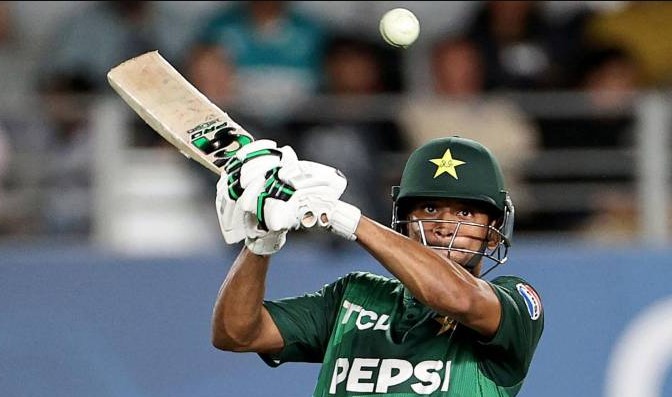Hassan Nawaz Makes History with Pakistan’s Fastest T20 Century
In the world of international cricket, a player’s debut innings can often set the tone for what follows in their career. Recently, Hassan Nawaz‘s blazing 44-ball century against New Zealand in a T20 match drew comparisons to Shahid Afridi’s unforgettable hundred, which was struck in just 37 balls during his second-ever international appearance in 1996. While both centuries were remarkable, the context and significance of each one make for an interesting comparison, particularly when examining the circumstances and the nature of the innings.
Hassan Nawaz’s Entrance- A Tale of Two Debuts
One of the most striking aspects of Nawaz’s rapid century is that it came in his third international innings, following two ducks in earlier matches. In contrast, Afridi’s introduction to the international stage was much more dramatic. He didn’t even get to bat in his debut match, with players like Saqlain Mushtaq coming in ahead of him. However, in his second match, against Sri Lanka, Afridi was promoted to number three, a position he hadn’t been slated for previously, which speaks to the unpredictability that often defines Pakistan cricket.
Afridi, just 16 years old at the time, embraced his opportunity with astonishing audacity, smashing the fastest-ever century in international cricket (then) off just 37 balls. The impact of that innings was immediate, and the cricketing world was left in awe of the young prodigy’s aggressive style. Nawaz, however, made his mark later in his career, with his fast century coming under different conditions.
The Scoring Rates- A Comparison of Speed between Hassan Nawaz and Shahid Afridi
In terms of raw speed, Nawaz reached three figures in just 44 balls, a phenomenal effort. However, Afridi’s innings was even more blistering, as he reached his century in only 37 balls. This difference in scoring rates underscores the ferocity of Afridi’s knock, which set a benchmark that would stand for over a decade. Nawaz’s 44-ball century is one of the fastest in T20 cricket, but Afridi’s achievement in the 50-over format, where such rapid scoring was less common, remains a benchmark for aggression and timing.
The Context- When and Why They Scored
The context of the two centuries is perhaps the most intriguing aspect of this comparison. Nawaz’s century came in a T20 match, where scoring rapidly is almost a given, especially when chasing a target as high as 205. In T20 cricket, players are encouraged to take risks and hit boundaries to accelerate the chase. The format inherently demands this type of play, and Nawaz’s approach fit seamlessly into the expectations of modern-day T20 cricket.
Afridi’s knock, on the other hand, came in a 50-over game, which offers more time for calculated innings. The match in question was against Sri Lanka in 1996, a time when fast centuries were an anomaly. The previous record for the fastest century in ODIs had been set at 62 balls, a milestone achieved by the legendary Sanath Jayasuriya. Afridi not only broke that record but did so by a margin that left the cricketing world stunned. His 37-ball hundred shattered the boundaries of what was thought possible in a 50-over format.
What makes Afridi’s achievement even more remarkable is the fact that it came in 1996, a time when limited-overs cricket was still evolving. His innings was so far ahead of its time that it took 18 years for anyone to surpass it, and even then, it was only bettered by a single ball.
The Bigger Picture- More Than Just Numbers
Afridi’s hundred wasn’t just a display of raw power; it was a reflection of the world in which it happened. In 1996, ODIs were not as fast-paced as they are today, and the idea of a player smashing a century in 37 balls was nearly unthinkable. It spoke to Afridi’s unique ability to redefine the game and challenge cricketing norms. While Nawaz’s century came in a context where fast scoring is more common, Afridi’s innings is remembered as an act of sheer audacity and a display of unrivaled talent.
The Support Cast
In addition to Nawaz’s remarkable batting performance, the match also saw solid contributions from his teammate Mohammad Haris, who scored 41 runs off 20 balls, forming a strong partnership with Nawaz. However, it was Nawaz who kept the pressure on the New Zealand bowlers, continuing his aggressive stroke play after the powerplay overs. Captain Salman Agha also played a crucial role, scoring 51 runs off 31 balls and finishing the match with back-to-back boundaries, ensuring that Pakistan remained in the hunt despite ultimately losing the match.
Pakistan’s bowlers, particularly Haris Rauf, also made a notable impact. Rauf claimed three wickets for 29 runs, restricting New Zealand to a total they had to chase. However, despite Nawaz’s rapid century and Haris’ tight bowling, New Zealand led the series 2-1.
While Nawaz’s 44-ball century was an incredible feat in the context of modern T20 cricket, Shahid Afridi’s 37-ball ODI century remains one of the most remarkable innings in cricket history. The differences in context, format, and timing of the two centuries make each achievement significant in its own right. Afridi’s innings is a historic moment in ODI cricket, one that transcended the expectations of its time, while Nawaz’s performance is a symbol of the aggressive nature of today’s T20 game. Both innings are testimony to the ever-evolving nature of the sport, where the bar is continually raised.
Also Read –
Violence Erupts Over Aurangzeb Tomb Dispute, Curfew Imposed in Nagpur
